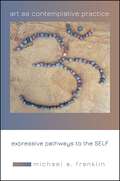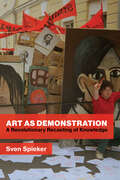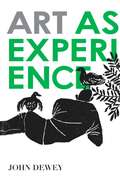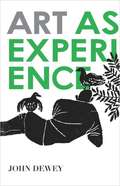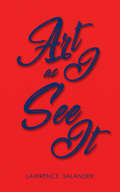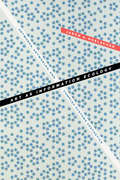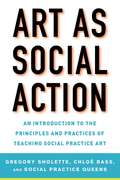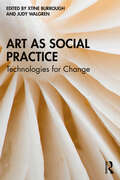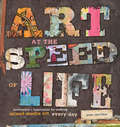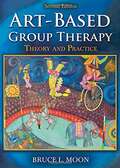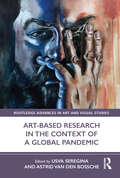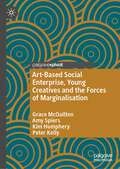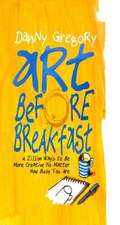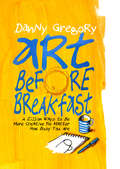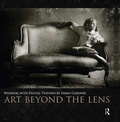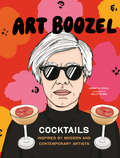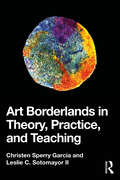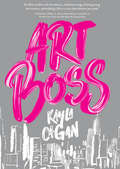- Table View
- List View
Art as Contemplative Practice: Expressive Pathways to the Self
by Michael A. FranklinDrawing upon his personal experience as a practitioner-researcher, visual artist, and cancer survivor, Michael A. Franklin offers a rich and thought-provoking guide to art as contemplative practice. His firsthand experience and original artwork complement this extensive discussion by consulting various practice traditions including yoga, rasa and darshan experiences, imaginal intelligence, and the contemplative instincts of select early twentieth-century artists. From this synthesis, Franklin suggests that we treat art as a form of yoga and meditation with the potential to awaken deeper insight into the fundamental nature of the Self. Exercises and rubrics are included that offer accessible instruction for any artist, meditation or yoga practitioner, art educator, or art therapist.
Art as Culture: An Introduction to the Anthropology of Art
by Evelyn Payne Hatcheran introduction of art as it relates to anthropology
Art as Demonstration: A Revolutionary Recasting of Knowledge
by Sven SpiekerHow artists wield demonstration to question the status quo both aesthetically and politically, marshaling art and education as powerful agents of change.Demonstration, in short, says: See here. It is the practice of pointing to something in order to explain or contest it. As such, Sven Spieker argues that demonstration has helped reshape art from the height of the Cold War to the late twentieth century, reformatting our understanding of how art and political engagement relate to each other. Focusing on Western Europe (especially Germany), Eastern Europe, and the United States, Art as Demonstration expands on contemporary discussions of art-as-protest, activism, and resistance. Spieker shows how a closer, more historical look at art&’s connection with demonstration reconnects us with earlier efforts, notably by the early twentieth-century avant-garde, to marshal art for the purpose of instruction and engagement.Art as Demonstration reconceives the history of postwar art in Eastern and Western Europe from the perspective of demonstration, understood formally (as a technique for showing and pointing) as well as politically (as protest, resistance, etc.). Close analyses of individual artworks reveal how the deployment of demonstration has changed over time. Spieker shows how &“protest&” and &“resistance&” organize art and artists not only politically but also and especially formally and aesthetically—a development of particular importance in the Cold War art and politics of Eastern Europe. The book illustrates how from the 1960s onward demonstration radically changed the way artists thought about art: no longer as an object but as a form of education.
Art as Experience
by John DeweyBased on John Dewey's lectures on esthetics, delivered as the first William James Lecturer at Harvard in 1932, Art as Experience has grown to be considered internationally as the most distinguished work ever written by an American on the formal structure and characteristic effects of all the arts: architecture, sculpture, painting, music, and literature.
Art as Experience
by John DeweyBased on John Dewey's lectures on esthetics, delivered as the first William James Lecturer at Harvard in 1932, Art as Experience has grown to be considered internationally as the most distinguished work ever written by an American on the formal structure and characteristic effects of all the arts: architecture, sculpture, painting, music, and literature.
Art as I See It
by Lawrence SalanderA working painter for over 50 years, and owner and director of the internationally renowned Salander-O'Reilly Galleries in New York City, where he was responsible for presenting over 600 museum quality exhibitions of art to the public, Salander is in a unique position to have a deep insight of all aspects of art and its making. This is an extremely personal book, and it is evident that Salander is both passionate and knowledgeable about his subject.
Art as Information Ecology: Artworks, Artworlds, and Complex Systems Aesthetics (Thought in the Act)
by Jason A. HoelscherIn Art as Information Ecology, Jason A. Hoelscher offers not only an information theory of art but an aesthetic theory of information. Applying close readings of the information theories of Claude Shannon and Gilbert Simondon to 1960s American art, Hoelscher proposes that art is information in its aesthetic or indeterminate mode—information oriented less toward answers and resolvability than toward questions, irresolvability, and sustained difference. These irresolvable differences, Hoelscher demonstrates, fuel the richness of aesthetic experience by which viewers glean new information and insight from each encounter with an artwork. In this way, art constitutes information that remains in formation---a difference that makes a difference that keeps on differencing. Considering the works of Frank Stella, Robert Morris, Adrian Piper, the Drop City commune, Eva Hesse, and others, Hoelscher finds that art exists within an information ecology of complex feedback between artwork and artworld that is driven by the unfolding of difference. By charting how information in its aesthetic mode can exist beyond today's strictly quantifiable and monetizable forms, Hoelscher reconceives our understanding of how artworks work and how information operates.
Art as Social Action: An Introduction to the Principles and Practices of Teaching Social Practice Art
by Gregory Sholette Chloë Bass Social Practice Queens"Art as Social Action . . . is an essential guide to deepening social art practices and teaching them to students." —Laura Raicovich, president and executive director, Queens MuseumArt as Social Action is both a general introduction to and an illustrated, practical textbook for the field of social practice, an art medium that has been gaining popularity in the public sphere. With content arranged thematically around such topics as direct action, alternative organizing, urban imaginaries, anti-bias work, and collective learning, among others, Art as Social Action is a comprehensive manual for teachers about how to teach art as social practice. Along with a series of introductions by leading social practice artists in the field, valuable lesson plans offer examples of pedagogical projects for instructors at both college and high school levels with contributions written by prominent social practice artists, teachers, and thinkers, including: Mary Jane Jacob Maureen Connor Brian Rosa Pablo Helguera Jen de los Reyes Jeanne van Heeswick Jaishri Abichandani Loraine Leeson Ala Plastica Daniel Tucker Fiona Whelan Bo Zheng Dipti Desai Noah Fischer Lesson plans also reflect the ongoing pedagogical and art action work of Social Practice Queens (SPQ), a unique partnership between Queens College CUNY and the Queens Museum.
Art as Social Practice: Technologies for Change
by Xtine Burrough Judy WalgrenWith a focus on socially engaged art practices in the twenty-first century, this book explores how artists use their creative practices to raise consciousness, form communities, create change, and bring forth social impact through new technologies and digital practices. Suzanne Lacy’s Foreword and section introduction authors Anne Balsamo, Harrell Fletcher, Natalie Loveless, Karen Moss, and Stephanie Rothenberg present twenty-five in-depth case studies by established and emerging contemporary artists including Kim Abeles, Christopher Blay, Joseph DeLappe, Mary Beth Heffernan, Chris Johnson, Rebekah Modrak, Praba Pilar, Tabita Rezaire, Sylvain Souklaye, and collaborators Victoria Vesna and Siddharth Ramakrishnan. Artists offer firsthand insight into how they activate methods used in socially engaged art projects from the twentieth century and incorporated new technologies to create twenty-first century, socially engaged, digital art practices. Works highlighted in this book span collaborative image-making, immersive experiences, telematic art, time machines, artificial intelligence, and physical computing. These reflective case studies reveal how the artists collaborate with participants and communities, and have found ways to expand, transform, reimagine, and create new platforms for meaningful exchange in both physical and virtual spaces. An invaluable resource for students and scholars of art, technology, and new media, as well as artists interested in exploring these intersections.
Art at the Speed of Life: motivation + inspiration for making mixed-media art every day
by Pam CarrikerOffering terrific mixed-media art projects, as well as great tips for getting organized and inspired, Art at the Speed of Life is a treasure chest of ideas for the artist whose fiery enthusiasm for creating art goes up in smoke after that frantic pace of a long day. Author and mixed-media artist Pam Carriker will prove to you that art and life can co-exist productively and happily, while making daily creative outlets a reality and not just wishful thinking.Each chapter in Art at the Speed of Life includes both essays and project ideas from a variety of contributors, including Suzi Blu, Lisa Bebi, Christy Hydeck, Paulette Insall, Cate Calacous Prato. It all begins with prepatory advice on how to manage your supplies and physically make space for you to work. This is followed by more than 15 projects that are inspiring, yet easy to complete on even the tightest of schedules and includes fun techniques such as assemblages, image transfers, and collages that are sure to keep you motivated. Plus, a bonus seven-day project journal helps you track your work as you go. Offering a unique combination of realistic time-management tips, inspiring essays, and easy-to-fit-in projects, Art at the Speed of Life will help you realize your dream of making art every day easily and happily.
Art-based Group Therapy: Theory And Practice
by Bruce L. MoonIn this second edition Moon provides essential principles regarding art-based therapy groups. The book is intended for art therapy students and practitioners, offering philosophic and practical information related to the use of art in a host of group therapy contexts.
Art-based Group Therapy: Theory and Practice
by Bruce L. MoonPerhaps more than ever before, today's art therapists are being encouraged to apply their knowledge base to the development of strategies for community building, and art-based approaches to preventing and treating emotional problems. In many settings, individual counseling or psychotherapy is no longer financially feasible. Art-based group therapy allows art therapists to work with many more clients than would be possible in individual sessions. Moreover, art-based group process also has unique qualities that can often serve as the treatment of choice for many clients.
Art-Based Research
by Shaun McniffArt therapy and all of the other creative arts therapies have promoted themselves as ways of expressing what cannot be conveyed in conventional language. Why is it that creative arts therapists fail to apply this line of thinking to research? In this exciting and innovative book, Shaun McNiff, one of the field's pioneering educators and authors, breaks new ground in defining and inspiring art-based research. He illustrates how practitioner-researchers can become involved in art-based inquiries during their educational studies and throughout their careers, and shows how new types of research can be created that resonate with the artistic process. Clearly and cogently expressed, the theoretical arguments are illustrated by numerous case examples, and the final part of the book provides a wealth of ideas and thought provoking questions for research. This challenging book will prove invaluable to creative art therapy educators, students, and clinicians who wish to approach artistic inquiry as a way of conducting research. It will also find a receptive audience within the larger research community where there is a rising commitment to expanding the theory and practice of research. Integrating artistic and scientific procedures in many novel ways, this book offers fresh and productive visions of what research can be.
Art-Based Research in the Context of a Global Pandemic (Routledge Advances in Art and Visual Studies)
by Usva Seregina Van den Bossche, AstridLiving through the Covid-19 global pandemic has changed the way that we experience our lives, the way that we relate to one-another, and the way that we engage with the world. Focusing contextually on the initial lockdowns of the pandemic in 2020, this book proposes that art-based research has a central, illuminative role to play in our understanding of unfolding crises. The changes brought on by the global event may not be readily accessible or expressible through traditional academic research. Art-based research offers the opportunity to explore, document, and reflect on the emerging and often ineffable qualities of transformed lives by drawing on emotional, bodily, and interactive aspects of experience. Such an approach allows for meaning-making that makes room for reflexive, interpersonal, and dialogical engagement. The contributions aim to capture and explore lived experiences of the pandemic, as well as begin a discussion about how meaning-making is changing through and beyond the pandemic. This book further explores how the nature and practice of art-based research in itself has been challenged and transformed. The book will be of interest to scholars working in art education, art psychotherapy, consumer research, visual studies, cultural studies, and sociology.
Art-Based Social Enterprise, Young Creatives and the Forces of Marginalisation
by Grace McQuilten Amy Spiers Kim Humphery Peter KellyThis book analyses the challenges and opportunities faced by art-based social enterprises (ASEs) engaging young creatives in education and training and supporting their pathways to the creative industries. In doing so, it addresses the complex intersecting issues of marginality and entrepreneurship, particularly in relation to young creatives from socially, economically and culturally diverse backgrounds. Drawing on extensive fieldwork and interviews with twelve key organisations, and three in-depth case studies in Australia, the book offers a detailed analysis of using enterprise to engage with the structural challenges of marginality. The book explores the local and global contexts through which art-based social enterprises (ASEs) operate and within which they attempt – often successfully – to improve access to education and work for emerging creatives. It also attends to the findings generated through engaging with the lived experiences of the staff and young creatives involved in our ASE case studies, in order to understand both the challenges and impacts of the ASE model on young people’s education, training, and employment pathways. The book focuses on three broad themes; precarious youth and digital futures, material practice and sustainable economies, and cultural citizenship in the urban fringe. In exploring these themes, the book contributes to debates about the limits, possibilities and challenges that attach to, and emerge from, an ASE model and highlights the ways in which these models can contribute to young people’s well-being, engagement, education and training, and work pathways. More broadly, it examines the possibilities of art as a means of social and cultural engagement. In the context of the precarious future of the creative industries, this book emphasise the ways in which young artists are building alternative economic and cultural models that support both individual pathways and collective change. This book will move the field forward with a critical lens that engages closely with experience and the lived realities of juggling multiple priorities of social, economic and artistic goals.
Art & Beauty
by Maurice de WulfThis work attempts to establish a philosophy of art that is both intellectual and objective. At first sight it may appear that these goals are at variance with contemporary ideas. On closer examination, however, the reader will see that the tendency is in the opposite direction, a closer approach to present-day thought rather than a departure from it. To admit that there exists a world other than that of our subjective states is to subscribe to an interpretation more in keeping with the real, and thus also with artistic reality. The intellectual and objective philosophy to which this book appeals in order to interpret the beauty of art will not be an intrusion, if it guards against all exclusiveness and does not itself compromise that which gives it its value.
Art Before Breakfast
by Danny GregoryPacked with the signature can-do attitude that makes beloved artist Danny Gregory a creativity guru to thousands across the globe, this unique guide serves up a hearty helping of inspiration. For aspiring artists who want to draw and paint but just can't seem to find time in the day, Gregory offers 5- to 10-minute exercises for every skill level that fit into any schedule--whether on a plane, in a meeting, or at the breakfast table--along with practical instruction on techniques and materials, plus strategies for making work that's exciting, unintimidating, and fulfilling. Filled with Gregory's encouraging words and motivating illustrations, Art Before Breakfast teaches readers how to develop a creative habit and lead a richer life through making art.
Art Before Breakfast: A Zillion Ways to be More Creative No Matter How Busy You Are
by Danny GregoryPacked with the signature can-do attitude that makes beloved artist Danny Gregory a creativity guru to thousands across the globe, this unique guide serves up a hearty helping of inspiration. For aspiring artists who want to draw and paint but just can't seem to find time in the day, Gregory offers 5– to 10–minute exercises for every skill level that fit into any schedule—whether on a plane, in a meeting, or at the breakfast table—along with practical instruction on techniques and materials, plus strategies for making work that's exciting, unintimidating, and fulfilling. Filled with Gregory's encouraging words and motivating illustrations, Art Before Breakfast teaches readers how to develop a creative habit and lead a richer life through making art.
Art before the Law
by Ruth RonenEver since Plato expelled the poets from his ideal state, the ethics of art has had to confront philosophy's denial of art's morality. In Art before the Law, Ruth Ronen proposes a new outlook on the ethics of art by arguing that art insists on this tradition of denial, affirming its singular ethics through negativity.Ronen treats the mechanism of negation as the basis for the relationship between art and ethics. She shows how, through moves of denial, resistance, and denouncement, art exploits its negative relation to morality. While deception, fiction, and transgression allegedly locate art outside morality and ethics, Ronen argues they enable art to reveal the significance of the moral law, its origins, and the idea of the good. By employing the thought of Freud and Lacan, Ronen reconsiders the aesthetic tradition from Plato through Kant and later philosophers of art in order to establish an ethics of art. An interdisciplinary study, Art before the Law is sure to be of interest both to academic philosophers and to those interested in psychoanalytic theory and practice.
Art beyond Itself: Anthropology for a Society without a Story Line
by David Frye Néstor García CancliniFirst published in Spanish in 2010, Art beyond Itself is Néstor García Canclini's deft assessment of contemporary art. The renowned cultural critic suggests that, ideally, art is the place of imminence, the place where we glimpse something just about to happen. Yet, as he demonstrates, defining contemporary art and its role in society is an ever more complicated endeavor. Museums, auction houses, artists, and major actors in economics, politics, and the media are increasingly chummy and interdependent. Art is expanding into urban development and the design and tourism industries. Art practices based on objects are displaced by practices based on contexts. Aesthetic distinctions dissolve as artworks are inserted into the media, urban spaces, digital networks, and social forums. Oppositional artists are adrift in a society without a clear story line. What, after all, counts as transgression in a world of diverse and fragmentary narratives? Seeking a new analytic framework for understanding contemporary art, García Canclini is attentive to particular artworks; to artists including Francis Alÿs, León Ferrari, Teresa Margolles, Antoni Muntadas, and Gabriel Orozco; and to efforts to preserve, for art and artists, some degree of independence from religion, politics, the media, and the market.
Art Beyond the Lens: Working with Digital Textures
by Sarah GardnerVintage-looking, dream-like textures can open up a whole new world in your photography. However, there is much, much more to working with textures than simply merging them with an image via Photoshop. In this gorgeous new guide from texture guru Sarah Gardner, you'll learn everything there is to know about how to maximize the potential of these exciting tools. In addition to hundreds of beautiful example images, this book is also packed with practical advice on what makes a good texture, and how and when to use them. How an image is initially captured and processed has a significant impact on the effect a texture will have, so you'll also learn what to consider when composing and shooting (rather than simply relying on post-processing) and how to use lighting and background considerations effectively for later work with textures. Workshop notes and a supplemental website will help you put Sarah's techniques into practice immediately. Beautiful enough to sit on your coffee table yet practical enough to store near your computer, this book will show you everything you need to know to get that coveted vintage-feel in your images, whether you're a casual family snapper or a seasoned professional.
Art Beyond The West
by Michael Kampen-O'RileyIn this major survey of the arts of Africa, Western and Central Asia, India, Southeast Asia, China, Korea, Japan, the Pacific, and the Americas, author Michael Kampen-O’Riley presents the vast range of arts that lie outside of the Western tradition. Within a predominantly geographic and chronological framework, he explores the arts of these areas from pre-history to present day. The first dedicated survey of “non-Western” art, Art Beyond the West is amply illustrated and accessibly written.
Art Boozel: Cocktails Inspired by Modern and Contemporary Artists
by Jennifer CrollRaise a glass to the world's most exciting modern and contemporary artists in this inspired cocktail book with over 50 tribute recipes.Go on a boozy tour of art history with this collection of recipes for over 50 expertly crafted cocktails, each one a unique creation inspired by its namesake artist. Unwind with a refreshing tequila-watermelon Frida Kahlo. Spark some inspiration while sipping on a Salvador Dalí. Or mix it up with a colorfully sweet Yayoi Kusama.From painters to sculptors, photographers, and more, each artist profiled has a cocktail recipe that draws deeply from their life and work. Both art lovers and cocktail enthusiasts alike will love pouring over this collection of engaging stories and unique recipes. Inventive and deliciously fun, ART BOOZEL will give you a new appreciation for each of these inspiring artists.INVENTIVE & FUN RECIPES: Each of these recipes draws from elements of the artist's life and work in colorful ways that any cocktail enthusiast will enjoy; think tomato garnishes in the Andy Warhol, golden turmeric in the Gustav Klimt, and flower syrup in the Georgia O'Keeffe.BESTSELLING TEAM: Jennifer Croll and Kelly Shami, the author and illustrator who brought you the wildly popular FREE THE TIPPLE, are back to deliver more of the colorful cocktail recipes and lush illustration that everyone loves.PERFECT FOR ART LOVERS: Any level of art appreciator will enjoy pouring over the diverse biographies and engaging portraits, and will love creating drinks inspired by their favorite modern and contemporary artists.Perfect for: mixology enthusiasts; art and art history lovers; museum and gallery visitors, especially visitors to SFMOMA, MoMA, and LACMA; readers of Punch, Bon Appétit, Saveur.
Art Borderlands in Theory, Practice, and Teaching
by Christen Sperry García Leslie C. Sotomayor IIResponding to an absence of Latine and Chicane artist and teaching resources, Art Borderlands in Theory, Practice, and Teaching shows how artists and educators can use borderlands, in-between geographical, emotional, cultural, and conceptual spaces, in three ways: theory, art practice, and teaching.Throughout this teaching-oriented text, the authors draw from borderlands theories and apply them to visual art and teaching. This volume centers art making and teaching practices based on borderlands lived experiences that are not commonly taught in higher education. Making productive the rupture and fragmentation that occurs in borderlands spaces, this text explores ways in which artists rebuild and become whole again through the process of making art. Using hands-on approaches, the authors model how to use borderlands theories in the classroom by employing arts-based and teaching methodologies. This includes access to Latine and Chicane centered digital information, interactive classroom activities, artist resources, and beyond the classroom learning experiences.Art Borderlands in Theory, Practice, and Teaching offers artists, students, and educators art making and teaching approaches that are centered on Latine and Chicane theories and concepts.
Art Boss
by Kayla CaganArtist Piper Perish has moved from her hometown of Houston, Texas, to New York City. Her days are spent exploring; her nights are filled with painting. It's her lifelong dream come true . . . . Except life in the city isn't as glamorous as it looks from afar. Piper's high-pressure work as an assistant to a famous modern artist takes away time from her own art. And Piper's new friend Grace, a budding activist, has Piper beginning to wonder if making great art is really enough.In a story that stands alone but can be read as a companion novel to Piper Perish, acclaimed author Kayla Cagan returns with Piper's powerful and utterly authentic journey of growing up into a strong, independent young woman—as she learns how to make life about art, and how to make that art matter. Art Boss will have readers asking big questions along with Piper. What is art for? What can art do? And how can a young artist change the world?
